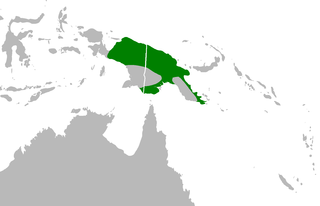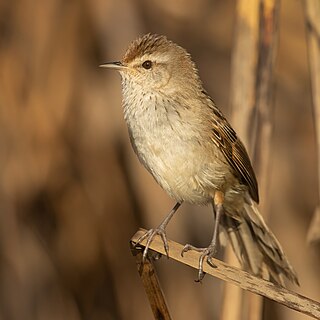
The pipits are a cosmopolitan genus, Anthus, of small passerine birds with medium to long tails. Along with the wagtails and longclaws, the pipits make up the family Motacillidae. The genus is widespread, occurring across most of the world, except the driest deserts, rainforest and the mainland of Antarctica.

The wagtails, longclaws, and pipits are a family, Motacillidae, of small passerine birds with medium to long tails. Around 70 species occur in five genera. The longclaws are entirely restricted to the Afrotropics, and the wagtails are predominantly found in Europe, Africa, and Asia, with two species migrating and breeding in Alaska. The pipits have the most cosmopolitan distribution, being found mostly in the Old World, but occurring also in the Americas and oceanic islands such as New Zealand and the Falklands. Two African species, the yellow-breasted pipit and Sharpe's longclaw, are sometimes placed in a separate seventh genus, Hemimacronyx, which is closely related to the longclaws.

The water pipit is a small passerine bird which breeds in the mountains of Southern Europe and the Palearctic eastwards to China. It is a short-distance migrant; many birds move to lower altitudes or wet open lowlands in winter.

Richard's pipit is a medium-sized passerine bird which breeds in open grasslands in the East Palearctic. It is a long-distance migrant moving to open lowlands in the Indian subcontinent and Southeast Asia. It is a rare but regular vagrant to western Europe.

The red-throated pipit is a small passerine bird, which breeds in the far north of Europe and the Palearctic, with a foothold in northern Alaska. It is a long-distance migrant, moving in winter to Africa, South and East Asia and the West Coast United States. It is a vagrant to Western Europe.

The olive-backed pipit is a small passerine bird of the pipit (Anthus) genus, which breeds across southern, north central and eastern Asia, as well as in the north-eastern European Russia. It is a long-distance migrant moving in winter to southern Asia and Indonesia. Sometimes it is also called Indian pipit or Hodgson's pipit, as well as tree pipit owing to its resemblance with the tree pipit. However, its back is more olive-toned and less streaked than that species, and its head pattern is different with a better-marked supercilium.

The American pipit, formerly known as the Buff-bellied pipit, is a small songbird native to North America. It was first described by Marmaduke Tunstall in his 1771 Ornithologia Britannica. It was formerly classified as a form of the water pipit. The former subspecies, Siberian pipit, is now considered a distinct species.

The paddyfield pipit or Oriental pipit is a small passerine bird in the pipit and wagtail family. It is a resident (non-migratory) breeder in open scrub, grassland and cultivation in southern Asia east to the Philippines. Although among the few breeding pipits in the Asian region, identification becomes difficult in winter when several other species migrate into the region. The taxonomy of the species is complex and has undergone considerable changes.

The plain-backed pipit or plain pipit is a medium-sized passerine bird which is a resident breeder in Africa south of the Sahara Desert.

The wandering whistling duck is a species of whistling duck. They inhabit tropical and subtropical Australia, the Philippines, Borneo, Indonesia, Papua New Guinea, and the Pacific Islands.

The singing bush lark or Horsfield's bush lark is a species of lark which inhabits grassland throughout most of Australia and much of Southeast Asia. It was described by the American naturalist Thomas Horsfield.

The Papuan harrier is a bird of prey native to New Guinea which belongs to the harrier genus Circus. It was classified as a subspecies of the eastern marsh harrier of eastern Asia.

The Nilgiri pipit is a distinctive species of pipit that is endemic to the high altitude hills of southern India. Richer brown in colour than other pipits in the region, it is distinctive in having the streaking on the breast continuing along the flanks. It is non-migratory and has a tendency to fly into low trees when disturbed and is closely related to the tree pipits Anthus hodgsoni and Anthus trivialis.

The African pipit is a fairly small passerine bird belonging to the pipit genus Anthus in the family Motacillidae. It is also known as the grassveld pipit or grassland pipit. It was formerly lumped together with the Richard's, Australian, mountain and paddyfield pipits in a single species, Richard's pipit, but is now often treated as a species in its own right.
Australasian pipit has been split into two species:

The New Zealand pipit is a fairly small passerine bird of open country in New Zealand and outlying islands. It belongs to the pipit genus Anthus in the family Motacillidae.

The little grassbird is a species of Old World warbler in the family Locustellidae. It is found in Australia and in West Papua, Indonesia. These sexually monomorphic birds are found in reed beds, rushes, lignum swamps and salt marshes of Southeastern Australia.

The rufous fieldwren also known as the desert wren or sandplain wren is a species of insectivorous bird in the family Acanthizidae, endemic to Australia.

The Australian swiftlet is a small bird belonging to the genus Aerodramus in the swift family, Apodidae. It is endemic to Queensland in north-eastern Australia. It was formerly included in the white-rumped swiftlet but is now commonly treated as a separate species. It has two subspecies which are occasionally regarded as two separate species: A. t. terraereginae and A. t. chillagoensis.

The wood pipit or woodland pipit is a small passerine bird belonging to the pipit genus Anthus in the family Motacillidae. It was formerly included in the long-billed pipit but is now frequently treated as a separate species. It is a bird of miombo woodland in south-central Africa, unlike the long-billed pipit which inhabits open grassland. It perches in trees when flushed but forages on the ground for invertebrates.




















